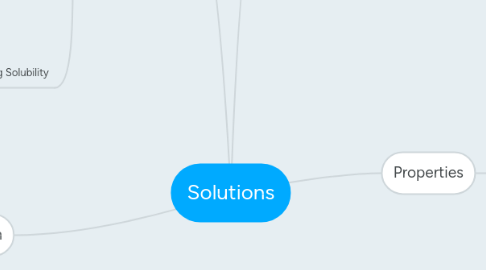
1. Classification
1.1. Saturation
1.1.1. How much solute can be dissolved into solvent?
1.1.2. The more solute in the solvent, the more saturated
1.1.2.1. Unsaturated
1.1.2.2. Saturated
1.1.2.3. Supersaturated
2. Solubility
2.1. The maximum amount of solute that will dissolve in given quantity of solvent
2.2. Why do substances dissolve?
2.2.1. Solubility based on potential intermolecular forces
2.2.1.1. London Dispersion Forces
2.2.1.2. Hydrogen Bonding
2.2.1.3. Dipole- Dipole Forces
2.2.2. "like dissolves like"
2.2.2.1. Polar substances dissolve polar substances
2.2.2.2. Non-polar dissolves non-polar
2.2.3. Making and breaking ionic bonds and/or intermolecular forces
2.3. Steps of dissolving at the Molecular level
2.3.1. 1. Forces between particles in solute must be broken
2.3.2. 2. Some intermolecular forces between particles in solvent must be broken
2.3.3. 3. Attraction between particles of solute and solvent
2.4. Forces Affecting Solubility
2.4.1. Temperature
2.4.1.1. When solvent is heated, more energy is present in the system, increases dissolve rate
2.4.2. Agitation
2.4.3. Particle size/surface area
2.4.3.1. Greater surface area, faster rate of dissolve
2.4.4. Pressure
2.4.4.1. gases are affected the most
2.4.4.2. solubility of gas in a liquid increases with more pressure
3. What is a Solution?
3.1. Mixture of 2 or more substance
3.1.1. Homogeneous
3.1.1.1. Looks like a single substance
3.1.1.2. Substances combined seamlessly
3.2. Solute dissolves in a solvent
3.3. Can be formed in any initial state; solid, liquid, gas
4. Properties
4.1. Electrolyte
4.1.1. Highly soluble ionic compound
4.1.2. Conducts electricity
4.2. Non-Electrolyte
4.2.1. Form solutions
4.2.2. Do not conduct electricity
4.3. pH
4.3.1. Acidic?
4.3.2. Basic?
4.3.3. Neutral?
4.4. It is a physical change when solution is created
4.4.1. Components can be separated by methods such as....
4.4.1.1. Boiling
4.4.1.2. Filtering
4.4.1.3. Crystallization
4.4.1.4. Distillation
4.4.2. Miscible
4.4.2.1. Solutions readily dissolve in each other
4.4.3. Immiscible
4.4.3.1. Solutions do not readily dissolve in each other
